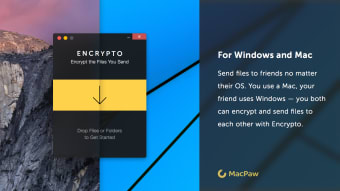
- #FILEVAULT VS. ENCRYPTO APP HOW TO#
- #FILEVAULT VS. ENCRYPTO APP CODE#
- #FILEVAULT VS. ENCRYPTO APP PASSWORD#
- #FILEVAULT VS. ENCRYPTO APP WINDOWS 7#
And given that FileVault doesn’t take up too much CPU while running (unless you create large files), there’s no reason why you shouldn’t turn it on. If you’re the only person who uses your Mac, you might think it’s okay to forego it, but that’s not a risk you’d want to take with your data.

This is especially important if you share your Mac with other people, like co-workers or family members. Given that it runs in the background, there’s no downtime due to the tool encrypting your data. We advise that every Mac user take advantage of FileVault to protect their data. In fact, we talk about it so much that we tend to neglect to protect our privacy on our personal computers, but it’s just as important. We all know how important it is to protect your online privacy. It’s one of the multiple ways to encrypt your files and folders on your Mac. It works in the background so you can continue to use your computer as you usually would. It also automatically encrypts any files you create going forward, like when you import your photos from your iPhone to your Mac.įileVault encrypts your data when your Mac is on and plugged in. When you turn the feature on, it encrypts all existing files on your startup disk. That means that no one can have unauthorized access to that data. We're the Internet privacy company for everyone who's had enough of hidden online tracking and wants to take back their privacy now.As the name suggests, FileVault is a built-in Mac tool that protects the data on your startup disk by encrypting it. See more tips to protect your privacy on Android.įor further information, this guide to encryption is recommended.įor more privacy advice, follow us on Twitter & get our privacy crash course. Remember to keep the phone plugged in until complete. Read the notice and press “Encrypt phone” to start the encryption process.

#FILEVAULT VS. ENCRYPTO APP PASSWORD#
Make sure a password or PIN is set in Security > Screen lock. Plug in the device to charge the battery (required).

See more tips to protect your privacy on iPhone. You should see the “Data protection is enabled” message.
#FILEVAULT VS. ENCRYPTO APP CODE#
Press “Passcode options” to choose a custom numeric or alphanumeric code (recommended).Ĭonfirm your device is encrypted by scrolling to the bottom of the Settings > Touch ID & Passcode screen. Press “Turn Passcode On” if not enabled already.
#FILEVAULT VS. ENCRYPTO APP WINDOWS 7#
See more tips to protect your privacy on Windows 7 and Windows 10. IMPORTANT: Make a backup of the recovery key using one of the displayed methods.Ĭhoose whether to encrypt used disk space only (faster) and start the encryption process. Go to Control Panel > BitLocker Drive Encryption.Ĭlick “Turn on BitLocker” next to the drive you want to encrypt.Įnter a long and varied alphanumeric password or passphrase. Note: BitLocker may not be available in all versions of Windows. See more tips to protect your privacy on Mac. Wait for encryption to complete, but it’s OK to continue using the computer. IMPORTANT: Make a note of the recovery key that is displayed and store it away from your Mac. Go to System Preferences > Security & Privacy > FileVault. Once complete, you will only need to enter a password when turning on or waking up your device to automatically decrypt your data.

When data is encrypted, it turns into a seemingly random collection of characters, unless of course you have the decryption key! The ability to encrypt all the data on a device is now usually built-in to its operating system, meaning there is no good excuse not to protect your privacy in this manner.įollow the steps below for encrypting your devices.
#FILEVAULT VS. ENCRYPTO APP HOW TO#
How to Encrypt Your Devices Filed under Device Privacy Tips on


 0 kommentar(er)
0 kommentar(er)
